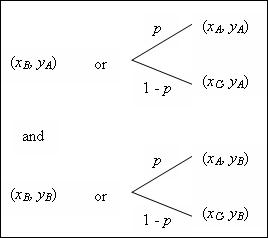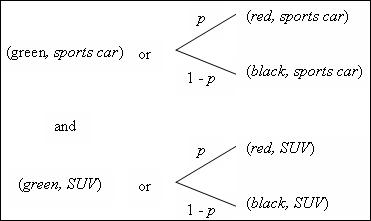Utility independence
From DDL Wiki
Current revision (15:44, 23 July 2007) (view source) |
|||
| (5 intermediate revisions not shown.) | |||
| Line 1: | Line 1: | ||
| - | In [[multiattribute utility theory]], | + | In [[multiattribute utility theory]], the last step is creating a multiattribute attribute utility function. There are several forms of this function, but the multiplicative and additive forms are easier to deal with because of its simplicity. However, certain conditions must hold in order to use these two forms. Besides utility independence, two other conditions are relevant as well. These are the [[preferential independence]] and [[additive independence]] conditions.<br /> |
| + | <br /> | ||
| + | An attribute set X is utility independent from attribute set Y if the utility for the attributes of set X does not change when the attributes in Y are varied. Utility independence can be tested using the lottery questions, as shown in the picture below.<br /> | ||
| + | [[Image:Utility_indep1.JPG]]<br /> | ||
| + | <br /> | ||
| + | <br /> | ||
| + | Take an example of two attribute sets of color (red/black/green) and style (sports car/SUV). The designer is indifferent between the certainty of a green sports car and a ''p'' chance of a red sports car and a ''1-p'' chance of a black sports car. If the decision maker is also indifferent between the certainty of a green SUV and a ''p'' chance of a red SUV and a ''1-p'' chance of a black SUV, with the value of ''p'' equal in both cases, then the attribute of color is utility independent from the attribute of style.<br /> | ||
| + | [[Image:Utility_indep2.JPG]]<br /> | ||
| + | <br /> | ||
| + | <br /> | ||
| + | This condition is a stronger condition than [[preferential independence]]. If two attributes are utility independent, then they must be preferentially independent as well. Additionally, attribute X may be utility independent from attribute Y, but not necessarily vice versa. | ||
| + | |||
| + | == References == | ||
| + | * Thurston, Deborah L. "Multi-attribute Utility Analysis of Conflicting Preferences." Decision Making in Engineering Design. Ed. Kemper E. Lewis, et al. New York, New York: ASME Press, 2006. 125-133. | ||
Current revision
In multiattribute utility theory, the last step is creating a multiattribute attribute utility function. There are several forms of this function, but the multiplicative and additive forms are easier to deal with because of its simplicity. However, certain conditions must hold in order to use these two forms. Besides utility independence, two other conditions are relevant as well. These are the preferential independence and additive independence conditions.
An attribute set X is utility independent from attribute set Y if the utility for the attributes of set X does not change when the attributes in Y are varied. Utility independence can be tested using the lottery questions, as shown in the picture below.
Take an example of two attribute sets of color (red/black/green) and style (sports car/SUV). The designer is indifferent between the certainty of a green sports car and a p chance of a red sports car and a 1-p chance of a black sports car. If the decision maker is also indifferent between the certainty of a green SUV and a p chance of a red SUV and a 1-p chance of a black SUV, with the value of p equal in both cases, then the attribute of color is utility independent from the attribute of style.
This condition is a stronger condition than preferential independence. If two attributes are utility independent, then they must be preferentially independent as well. Additionally, attribute X may be utility independent from attribute Y, but not necessarily vice versa.
References
- Thurston, Deborah L. "Multi-attribute Utility Analysis of Conflicting Preferences." Decision Making in Engineering Design. Ed. Kemper E. Lewis, et al. New York, New York: ASME Press, 2006. 125-133.


